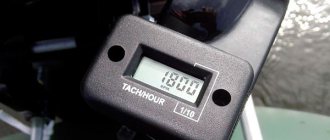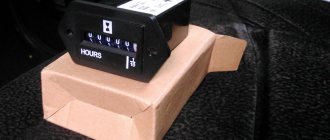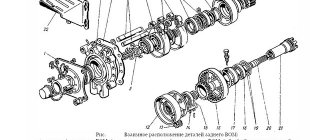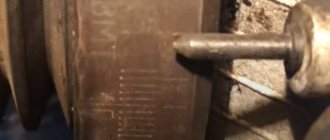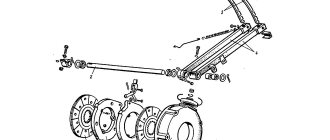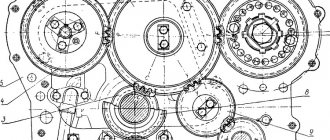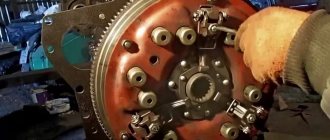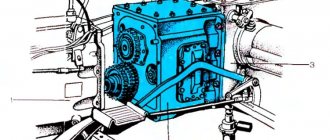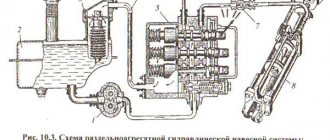Engine hours on a tractor - what is it, how to calculate it?
Many novice users of heavy agricultural machinery have probably wondered - what are the engine hours on a tractor, how to calculate them correctly and why are they needed at all? Let's consider the most popular questions regarding this unit of measurement of the capabilities of your tractor.
An engine hour is a non-linear unit of measurement of engine operating time. Nonlinear, because one such hour is not equal to one astronomical hour, this characteristic varies. It depends on the number of crankshaft revolutions per hour under different loads. This technological parameter is important in order to control the wear process of the main engine components, ensure their replacement in a timely manner, and simply to be aware of the capabilities of the tractor.
Fuel consumption - what you should pay priority attention to
Actual indicators for the MTZ 80 tractor are calculated based on observations of the vehicle.
The fact is that, based on operating conditions and climatic characteristics, they can have very significant differences, and that is why when making calculations they always take into account linear or, as they are also called, basic standards, using an overestimated correction factor for them. The fuel consumption rate is calculated based on the fact that the vehicle is in good technical condition. If everything is in order, the mileage is set at 100 km and the amount of fuel consumed during this period of travel is recorded. It is measured in liters, taking as a basis a machine hour, or a certain unit of labor with cyclic repetition.
To carry out the most accurate calculations, a special formula is used, which, however, is equally relevant not only for MTZ 80 tractors, but also for all other types of equipment, both agricultural and other.
How to calculate engine hours?
Methods for calculating engine hours for a diesel engine can be different - from simple mental calculation, with further recording of engine performance indicators, to the installation of special mechanical or electrical meters.
Naturally, the second option is more acceptable - this method of calculation is much more accurate and convenient. Using the counter indicators, you can more accurately monitor the degree of wear of the main operating components of a diesel engine. Data on this technical characteristic are specified in detail in the operating instructions.
Mini tractors with an engine capacity of less than 50 cubic centimeters
Mini tractors with an engine capacity of less than 50 cubic centimeters and an engine power of up to 5.5 liters. With. are means of small-scale mechanization for gardening use / agricultural machine and tractor units (motorized tools, object position code according to OK 005-93 - 473791). Taking into account their technical characteristics, they are not subject to the requirements for issuing passports for self-propelled vehicles; to operate them, it is not necessary to obtain a tractor driver’s (tractor driver) license. Mini tractors with an engine capacity of less than 50 cm3. are not a vehicle, nor a self-propelled machine, are intended for agricultural work only within the garden plot and cannot be used for transporting people, cargo or equipment on roads.
* “Agricultural machine-tractor unit” is a complex that is a combination of a mobile power vehicle with a trailed, semi-trailer or mounted machine (or machines) and is intended for performing technological agricultural operations; — TR TS 10/2011.
*"Motor vehicle" is a vehicle driven by an engine. The term also applies to any tractors and self-propelled machines. — Traffic regulations.
How many engine hours are in one hour?
You can calculate the average engine hours relative to real time using one simple non-mathematical formula that every tractor owner should know. You can convert engine hours into hours using the following algorithm:
- When operating at idle speed, the number of engine hours is 1 astronomical hour (that is, 60 minutes).
- In operating mode at moderate loads, the number of shaft revolutions increases by about a third, 1 engine hour becomes equal to approximately 40 minutes of real time.
- When operating under increased load conditions, engine speed increases by approximately 2/3. Under such conditions, one engine hour is equal to approximately 20 minutes.
Engine hour and machine hour: what is the difference?
As we have already found out, engine hours are the time of useful operation of the engine, during which the crankshaft produced a certain number of revolutions (depending on the load). Machine hour is a broader concept that includes not only the useful operating time of the engine, but also various breaks, relocation of equipment, maintenance, etc.
This concept is more applicable for established production processes and for regulating the level of payment. Machine hours are calculated by multiplying engine hours by a special conversion factor.
You may also like:
Features of engine hour calculation
What the engine hours on a tractor are is quite simple to imagine if you understand how this parameter is fixed.
At the moment the engine starts, a mechanical or electronic counter also turns on, which begins to record and remember the shaft speed using a special indicator. This device for determining the operating hours of tractors allows you to determine the duration of its operation for any period of time. But at the same time, the statement that 1 tractor hour is equal to one hour of real operating time is erroneous. The calculation is based on the number of revolutions per minute. Consequently, it may differ several times under load and at idle. It turns out that if you count the engine hours, you can find out the approximate degree of wear of the moving mechanical components of the power unit. The formula for calculating them is quite simple and is based on the number of revolutions:
- idling allows you to equate one engine hour to an hour of real time;
- a normal load “speeds up” the engine hour by about a third - 1Mh is approximately 40 minutes;
- intense load leads to “acceleration” of wear by two thirds.
Why do you need to count engine hours?
Having figured out how to calculate the engine hours on a tractor, you can now move on to the question of why these calculations are needed. First of all, the answer to this question lies in the peculiarities of the calculation process itself - it is based on the number of engine revolutions per minute. Considering that each moving mechanical joint has its own safety margin designated by the manufacturer, it is possible to calculate the time for scheduled engine maintenance in advance. At the same time, knowing how the hour meter on a tractor works, it is not difficult to do this accurately, based on the actual wear of the crankshaft, piston system and other components of the power plant.
Knowing the actual operating characteristics of the engine can easily convert engine hours into kilometers on a tractor in each individual case. There is a special average table that suggests that 1 m/h for wheeled tractors is 10 kilometers, for tracked ones - 5 kilometers. But for an accurate calculation, many factors must be taken into account, ranging from driving speed to engine load. In addition, the design of the sensor allows you to wind up the engine hours, turning any calculations into a useless exercise. Although today this is a rather rare occurrence, since the decision to “wind up” the meter belongs more to the “Soviet era”. At that time, the engine hour was one of the indicators of operating time, and today it is a means of saving, monitoring fuel consumption and the performance of the power unit.
Panel for MTZ with large cabin
Since 1980, Belarus MTZ 80(82) tractors began to be equipped with a large observation cabin. In this assembly, they began to install another panel, indicated by catalog article 80-3805010-D1, with autonomous instrumentation (with instrument panel 80-385021-01), which was subsequently installed on tractor brands MTZ 100(102), 1221.
The shield is made of composite plastic, is installed on top of the common body of the control devices and is a single inclined plane with a hole for the steering wheel. Three blocks with fuses are mounted under the front front cover of the shield in a separate compartment.
How to calculate engine hours - simple about complex things
The number of engine hours is one of the most important parameters of agricultural machinery, which indicates the working life of the engine, chassis and other important components of the unit. For many beginners, it is quite difficult to calculate this characteristic, much less convert it into kilometers. In fact, there is nothing complicated about this - just follow a number of tips that will help you understand the essence of this important parameter.
Give an answer to the question: “What are the engine hours on a tractor?” It’s quite simple if you understand how this important parameter is fixed. When the engine is started directly, an electronic or mechanical counter begins to work, recording and storing the speed of rotation of the engine shaft. For this purpose, a special indicator is provided in the meter design. This simple device makes it possible to calculate the duration of tractor operation over a certain period of time.
At the same time, the opinion that one engine hour of a tractor is equal to one hour of time will be erroneous. Calculation of engine hours in kilometers is done taking into account revolutions per minute. In this regard, this parameter may differ several times when the tractor is idling and under high loads.
How to calculate engine hours and machine hours - conversion to kilometers
A friend turned to me, like: “...put on ten hours... if possible, well, you’re a radio engineer, figure it out...” I figured it out on the second day.
There is almost no information on the internet, or come on over - we’ll do it! And don't worry, I'll do it myself! And did! Given: KD8083 on MTZ-83 We have: -25 hours As a result: we beat off the minus and went into plus for two days! Total: the processor (internal) was not reprogrammed, everything is in normal mode, astronomical hour = 1 hour. I did it on the NE555 (VI1) generator, only calculated and selected my own frequency data. As you can see in the photo, at 800 Hz = 3500 rpm.
In the old diagram (Fig. 1), the calculation is not correct (DO NOT repeat the diagram), but the dependence of frequency on revolutions has been measured in practice. Below is a diagram of the NE555, “in theory and on a prototype model”
The dependence of frequency on the clock is independent. The main thing: the signal frequency is at least 200 Hz! and At least 2 V!
PS I went to bed, photos tomorrow...
Scan with the old circuit, it doesn’t work, do it on VI1 or NE555, select a frequency of no more than 700 Hz!
Mileage correction
Professional mileage adjustment on all types of equipment.
Twist mileage
Twist the speedometer of absolutely any car, regardless of whether it is a mechanical odometer or an electronic one.
Engine hour correction
Adjustment of engine hours of construction and special equipment.
Rewind the speedometer
Check the mileage of cars, motorcycles, ATVs, snowmobiles.
Speedometer correction
Adjusting car speedometers.
Roll up mileage
Clock up kilometers on your car.
Rewind mileage
View mileage and engine hours on equipment.
Twist the engine clock
Calculate engine hours on all types of equipment, regardless of mechanical or electronic counter.
How many engine hours are in one hour?
Counting the engine hours spent by a tractor helps to understand the degree of wear on the most important moving mechanisms of the unit.
The formula used for the calculation is extremely simple and gives the tractor owner the following data:
- when operating an agricultural machine at idle speed, 1 engine hour is equivalent to one full hour of real time;
- with normal load on the tractor, one engine hour is accelerated by about a third, thus amounting to 40 minutes of real time;
- in case of operation of the unit under maximum loads, 1 engine hour is equal to 20 minutes of real time.
Using this information, even a novice farmer can easily convert engine hours to real-time hours. It should be remembered that the final result of converting engine hours into real-time clocks is always slightly different for a gasoline engine and a diesel engine. The main reason for this is the higher power of the latter, which is why it spends a little less time on completing tasks.
How to convert engine hours to kilometers?
Just as in the case of converting a tractor's engine hours into real-time clocks, beginners have difficulty converting engine hours into kilometers traveled by the tractor. In the second case, many more questions may arise, since it is almost impossible to accurately convert engine hours into kilometers - this can only be done relatively and approximately.
First of all, you need to remember that some manufacturers of agricultural machinery set almost identical conditions for calculating engine hours. In most cases, 50 of these units equals 5 kilometers traveled by the tractor under moderate loads. At the same time, if the tractor very often works under intense loads and regularly performs the functions of an assistant, both in the garden and in the local area, then the number of engine hours worked by it confidently increases upward without significant changes in its mileage.
It is important to remember that each tractor uses the motor resources inherent in its engine and other components differently. You can always find more accurate information about the features of calculating this important parameter in the operating instructions for the agricultural machine.
More accurate data on engine hours worked and kilometers traveled can be provided by the memory of the on-board computer, but this kind of device is provided only in the latest models of tractors put on the market, and then only in large-sized units designed to work on large areas.
What are engine hours on a tractor and other equipment: monitoring service life
Linguists have not come to a consensus on the question of how to correctly write the word “motor hours” - with a hyphen in the middle between the two roots or together. The “Dictionary of Russian Language Abbreviations”, as well as the “Spelling Dictionary” indicate that the word “motor hour” is written together. But writing with a hyphen is not considered an error.
Any mechanism has contacting parts that rub against each other during operation and gradually wear out. The more intense the operating mode, the more significant the wear of the working surfaces. When operating equipment, maintenance personnel are interested in such an important indicator as the remaining service life. The unit of measurement is considered to be “motor hour”. This value characterizes the duration of operation of the mechanism under load.
This is not just the operating time of the mechanism, it is an accounting of the operating time under certain conditions. Astronomical time is adjusted by the value of specific coefficients, which are the result of certain regime measurements. There are devices that remove almost all the necessary information from the mechanism, calculate it and provide the results to the mechanic in real time.
An engine hour is a unit of measurement for the duration of engine operation, taking into account the quantitative characteristics of all factors. For an internal combustion engine, the main measured quantity is the crankshaft revolutions - their number or rotation speed. The engine hour is either less or more than the astronomical hour.
There is no exact definition of the concept of “motor hour”. In practice, it is sometimes replaced by the usual concept of time, which is necessary in economic calculations, for example, to establish maintenance schedules.
How to calculate engine hours
In the practical work of auto mechanics, it is often necessary to count engine hours to draw up operation and maintenance schedules. The problem is not simple. There is no single, universally accepted counting algorithm. Different methods give different results. But as an initial assessment, they are still useful.
It is known that with an increase in the speed of rotation of the crankshaft, friction in contacting pairs increases and metal wear increases. With variable speeds, obtaining an objective result becomes much more difficult.
Calculations can be completely manual, made using records of readings taken from instruments. And automatic, performed by specialized devices. These devices are used in different types - mechanical, electromechanical, electronic, programmable. The calculation is based on engine speed measured by an automatic tachometer. The formula takes into account total and hourly fuel consumption, actual speed and other operating parameters.
1 hour of operation is taken to be 1 hour of operation of a machine developing rated power. The engine hour is equal to the astronomical operating hour under nominal conditions. At idle, the engine hour value is higher, and at increased load it is lower. These indicators are used to determine the timing of replacement of consumables and maintenance.
Monitoring engine hours in a car PHOTO: drivertip.ru
How to convert engine hours to hours
To convert engine hours into generally accepted time units, the nominal mode is usually taken as the reference point. With an increase in power and, accordingly, crankshaft speed, the number of engine hours in one astronomical hour increases by a third (moderate mode) and by two thirds (intensive mode). This method provides a rough but practically useful estimate of the mechanism's load and wear.
Engine hour: how many kilometers is it?
It is more correct to calculate engine life in engine hours than in kilometers. But practitioners more often use distance units for everyone. All maintenance schedules are tied to them. In practice, a special average table is used, which assumes that 1 engine hour for wheeled tractors is 10 km, for tracked tractors – 5 km. At the same time, more accurate calculations require taking into account and evaluating other indicators of operating conditions.
How to convert engine hours to kilometers
Since techies do not have a strict, unambiguous formulation of the concept of “motor hour,” these ideological differences are regulated by binding documents. According to the Order of the State Customs Committee of the Russian Federation dated October 2, 1996. No. 609 “On the introduction of annual standards for the consumption of motor resources (mileage) of vehicles”, introduces the concept of an average indicator for one hour of operation of a machine driven by a motor not equipped with an hour meter. It will be equal to the following mileage: for cars - 25 km; for wheeled tractors – 10 km; for tracked tractors – 5 km. If driving occurs in difficult conditions (driving at high speeds, in traffic jams, etc.), the number of engine hours increases, but the mileage does not keep up with their countdown. Maintenance recommendations given in kilometers (for example, 15-20,000 km) should be reduced. These wishes of the automaker are more consistent with ideal operating conditions.
How to count engine hours on a tractor - Special equipment
» Miscellaneous » How to calculate engine hours on a car
The engine hour is the time - one hour during which the engine has been running. But it's not that simple! The engine hour is still not entirely linear time.
This is one hour of operation of the crankshaft (its revolutions are counted on the tachometer) of the engine at certain speeds or, in relation to passenger cars, when the car is moving at a certain (usually low) speed and in a certain gearbox.
Such a characteristic as engine hours affects a number of indicators and recommendations for a particular car, the main ones being mileage, its ratio to engine life, the engine life itself is also more correctly calculated in engine hours, and not just in kilometers of the car, frequency of oil changes and etc.
What is the difference between mileage and engine hours? How to calculate the number of engine hours from a car's mileage? The answer to this question, unfortunately, is not so simple, or rather, it does not exist - it is impossible to accurately calculate the number of engine hours traveled, knowing the mileage of the car. However, this can be done relatively and approximately.
First of all, you should know that usually the manufacturers of most cars set approximately the same conditions for calculating engine hours, and most often 200-250 engine hours are equal to 15 thousand kilometers in the case of a calm, measured drive with a moderate amount of traffic jams and, in general, the engine idling (after all, in this case, the mileage does not increase, but the engine hours do).
But if, for example, you prefer aggressive driving at high engine speeds, often sit in traffic jams, or generally often stand with the engine running (heating up in a stationary car, for example), then this ratio increases in favor of engine hours - i.e. the latter becomes more than the mileage.
And in this case, you use up the life of the engine (and some other units) faster, you need to change the engine oil more often, and so on.
And if you often drive on the highway in a relaxed manner, your car rarely sits idle with the engine running and is more often in motion, then the calculation of engine hours by mileage should be made based on the fact that for the same 200-250 engine hours the mileage can reach 20,000 kilometers. However, if we are talking about regularly replacing fluids and oils in a car, based on these data, then this is exactly the case when “it’s better to be safe than sorry.”
Design and principle of operation of instruments for measuring engine hours
Understanding the importance and necessity of monitoring and accounting for the resource consumption of the unit, engineers developed and put into operation automatic devices - engine hour meters.
Features of hour meters and methods of their use
Different types of meters have been developed for different vehicles.
Hour meter for tractor
The calculation algorithm assumes that at idle, 1 engine hour of the tractor is equal to 1 hour of real time.
At standard load, the engine hour increases by almost a third. Under normal loads, 1 engine hour lasts approximately 40 minutes. Under intense load, the engine wears out two-thirds faster.
Hour meter for car
Different components of a car wear out differently during the same operating time. It is also important to consider whether the car was in motion or stood still with the engine running. These considerations apply to any vehicle. Typically, 200-250 engine hours for a car is 15,000 - 17,000 km. It all depends on how long the car has been parked with the engine running.
The presence of an hour meter in the car allows the owner to more competently plan maintenance and replacement of components and assemblies.
Different types of sensors have been developed for cars, depending on what unit they are supposed to monitor. All types are based on a time counter, but the difference between them lies in the method of activating the start of the countdown. They can start when the ignition is turned on, when the engine vibrates, or in other ways. The clock mechanism itself can be electromechanical or electronic.
Hour meters vary in price - from quite cheap (no more than 500 rubles), to expensive ones, designed for boats and yachts, in a sealed design, costing up to 8,000 rubles. There are also meters with mechanical drums, like in the odometers of old cars, only they count not kilometers, but engine hours.
Built-in universal tachometer RL-HM005L with hour meter and backlight (backlight only works from an external power supply of 6-48 V). Designed to measure engine speed and operating time. Can be used on motorcycles, snowmobiles, ATVs and outboard motors:
- two-stroke: 1, 2, 3 cylinders;
- four-stroke: 1, 2, 4, 6 cylinders.
For use with gasoline internal combustion engines only. Connects to the engine spark plug, the signal wire is wound around the spark plug
Hour meter for a car PHOTO: alligator-boat.ru
Hour meter for outboard motor
The peculiarity of this counter is that after the first turn on, the tachometer remains on all the time and displays the number of engine hours worked on the screen. You can forcefully turn off the tachometer by pressing and holding two special buttons, but then the engine hour meter will be reset. Switching between modes (tachometer or counter) occurs automatically: when the engine is running, the tachometer is displayed, after the engine is stopped, the hour meter is displayed.
Hour meter for diesel engine
One of the meter options for diesel is model TS-013. This is a non-contact digital tachometer with built-in hour meter function for diesel engines and electric vehicles.
Electronic hour meter for diesel engines PHOTO: mytahometr.ru
Engine hour meter for generator
Maintenance of units, including gas generators, is tied to engine hours or time intervals. The concept of engine hours is discussed above. In the case of a generator, a specific issue is signal pickup and protection from interference. There are capacitive sensors, their connection is non-contact. It is produced by wrapping several turns of the wire coming from the sensor, the high-voltage conductor of the spark plug. The second issue is solved by protecting the device with a tin screen.
Engine hour sensor for a gas generator PHOTO: radiobezdna.ru
Hour meter for walk-behind tractor
Portable non-contact digital inductive tachometer TS-011. Built-in functions of an hour meter and countdown until the next maintenance.
Hour meter for walk-behind tractor PHOTO: promotoblok.ru
Other varieties
Counters activated by pulses from the ignition system.
A counter activated by pulses from the ignition system PHOTO: drive2.ru
Counters activated by engine vibration.
Counter activated by engine vibration PHOTO: drive2.ru
Electromechanical meter with activation when power is applied.
Meter with activation when power is applied PHOTO: drive2.ru
MTZ-100
Universal row-crop wheeled tractors of the 1.4 tf class MTZ-100, MTZ-102, MTZ-80A, MTZ-82A are created on the basis of the MTZ-80 and MTZ-82 tractors with a high degree of unification. Tractors MTZ-100, MTZ-102, MTZ-80A, MTZ-82A are designed to perform a wide variety of agricultural work with mounted, semi-mounted and trailed machines and implements. They can be used to perform labor-intensive work in conjunction with bulldozers, excavators, loaders, hole diggers, as well as for transport work and to drive various stationary machines for both agricultural and industrial purposes.
Diesel
For MTZ-80A, MTZ-82A - D-240 For MTZ-100, MTZ-102 - D-245 (with turbocharging) Number of cylinders 4-row Cylinder diameter, mm 110 Piston stroke, mm 125 Compression ratio (calculated) 15, 1 (D-245), 16 (D-240) Cylinder displacement, l 4.75 Operating order 1-3-4-2
SAE Net Power Rating. kW (hp): D-240 57.4 (78) D-245 74 (100)
Turbocharger (diesel D-245) centripetal radial turbine on the same shaft with a TKR-7N-6 centrifugal compressor
Four-plunger fuel pump, with booster pump model: D-240 UTN-5 D-245 4UTNM-T
Injector FD-22 Fuel injection pressure MPa (kgf/cm2) 17.5-18.0 (175-180) Air cleaner combined with dry centrifugal and oil inertial contact air cleaning Diesel starting system electric starter 243708
Weight of dry diesel engine without clutch, kg: D-240 - 430 D-245 - 458
Electrical equipment
Power transmission
Clutch: MTZ-80A, MTZ-82A friction single-disc, dry, permanently closed type MTZ-100, MTZ-102 friction double-disc dry, permanently closed type
Transmission: speed, 8-band with shifting without interruption of power flow or synchronized Main gear: pair of bevel gears with spiral teeth Rear axle differential bevel with four closed satellites Rear axle differential locking mechanism friction clutch with automatic control from a sensor Final drives: single-stage spur gearboxes spur gears
